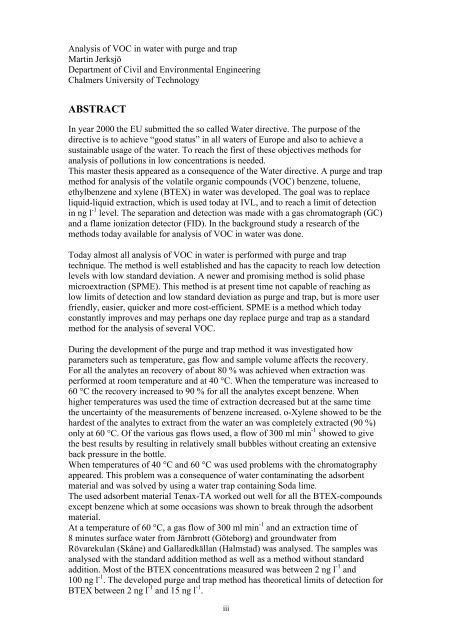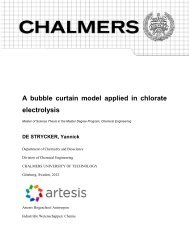egrup dem nettav i COV va sylanA kinket part dna - Chalmers ...
egrup dem nettav i COV va sylanA kinket part dna - Chalmers ...
egrup dem nettav i COV va sylanA kinket part dna - Chalmers ...
You also want an ePaper? Increase the reach of your titles
YUMPU automatically turns print PDFs into web optimized ePapers that Google loves.
Analysis of VOC in water with purge and trap<br />
Martin Jerksjö<br />
De<strong>part</strong>ment of Civil and Environmental Engineering<br />
<strong>Chalmers</strong> University of Technology<br />
ABSTRACT<br />
In year 2000 the EU submitted the so called Water directive. The purpose of the<br />
directive is to achieve “good status” in all waters of Europe and also to achieve a<br />
sustainable usage of the water. To reach the first of these objectives methods for<br />
analysis of pollutions in low concentrations is needed.<br />
This master thesis appeared as a consequence of the Water directive. A purge and trap<br />
method for analysis of the volatile organic compounds (VOC) benzene, toluene,<br />
ethylbenzene and xylene (BTEX) in water was developed. The goal was to replace<br />
liquid-liquid extraction, which is used today at IVL, and to reach a limit of detection<br />
in ng l -1 level. The separation and detection was made with a gas chromatograph (GC)<br />
and a flame ionization detector (FID). In the background study a research of the<br />
methods today a<strong>va</strong>ilable for analysis of VOC in water was done.<br />
Today almost all analysis of VOC in water is performed with purge and trap<br />
technique. The method is well established and has the capacity to reach low detection<br />
levels with low standard deviation. A newer and promising method is solid phase<br />
microextraction (SPME). This method is at present time not capable of reaching as<br />
low limits of detection and low standard deviation as purge and trap, but is more user<br />
friendly, easier, quicker and more cost-efficient. SPME is a method which today<br />
constantly improves and may perhaps one day replace purge and trap as a standard<br />
method for the analysis of several VOC.<br />
During the development of the purge and trap method it was investigated how<br />
parameters such as temperature, gas flow and sample volume affects the recovery.<br />
For all the analytes an recovery of about 80 % was achieved when extraction was<br />
performed at room temperature and at 40 °C. When the temperature was increased to<br />
60 °C the recovery increased to 90 % for all the analytes except benzene. When<br />
higher temperatures was used the time of extraction decreased but at the same time<br />
the uncertainty of the measurements of benzene increased. o-Xylene showed to be the<br />
hardest of the analytes to extract from the water an was completely extracted (90 %)<br />
only at 60 °C. Of the <strong>va</strong>rious gas flows used, a flow of 300 ml min -1 showed to give<br />
the best results by resulting in relatively small bubbles without creating an extensive<br />
back pressure in the bottle.<br />
When temperatures of 40 °C and 60 °C was used problems with the chromatography<br />
appeared. This problem was a consequence of water contaminating the adsorbent<br />
material and was solved by using a water trap containing Soda lime.<br />
The used adsorbent material Tenax-TA worked out well for all the BTEX-compounds<br />
except benzene which at some occasions was shown to break through the adsorbent<br />
material.<br />
At a temperature of 60 °C, a gas flow of 300 ml min -1 and an extraction time of<br />
8 minutes surface water from Järnbrott (Göteborg) and groundwater from<br />
Rö<strong>va</strong>rekulan (Skåne) and Gallaredkällan (Halmstad) was analysed. The samples was<br />
analysed with the standard addition method as well as a method without standard<br />
addition. Most of the BTEX concentrations measured was between 2 ng l -1 and<br />
100 ng l -1 . The developed purge and trap method has theoretical limits of detection for<br />
BTEX between 2 ng l -1 and 15 ng l -1 .<br />
iii
















